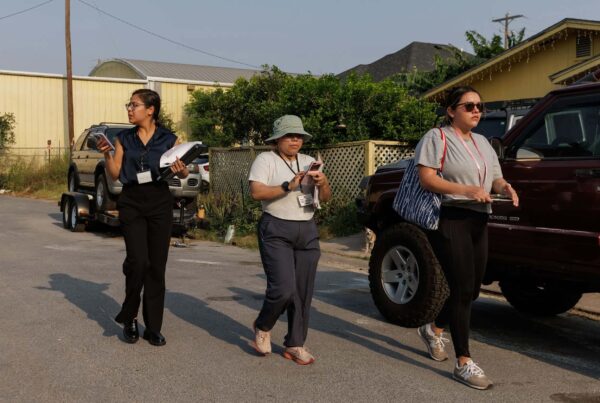As we head into summer, things tend to slow down a little bit. But for the Supreme Court, this is the busy season.
The high court usually hands down several rulings before its summer break, typically at the end of June. Not this year. The current docket is unusually full.
It isn’t just the amount of cases that’s unusual – the subject matter is pretty epic too. In addition to ruling on former President Trump’s immunity regarding Jan. 6, SCOTUS will also hand down decisions on gun rights, abortion, homelessness, and freedom of speech online just to name a few. While the results of all these cases could affect Texans, there are a few that actually started in the Lone Star State.
The court announced it will issue some decisions this Thursday and perhaps some more on Friday.
Stephen Vladeck, a professor at the University of Texas School of Law and a Supreme Court analyst for CNN, returned to Texas Standard to give us an idea of what to expect. Listen to the interview above or read the transcript below.
This transcript has been edited lightly for clarity:
Texas Standard: A couple of these cases have to do with free speech on social media, and Texas Attorney General Ken Paxton is the defendant in one of them. What can you tell us about that?
Stephen Vladeck: So the Supreme Court is considering laws enacted by both Texas and Florida that really are the first of their kind.
They were motivated by Republican cries of censorship on these platforms and basically ban companies like Twitter and Facebook and others from engaging in particular types of content moderation. And those laws were challenged on the ground that the states are basically telling these companies what they can and can’t say – what kind of content moderation rules they can and can’t have.
Every lower court to consider these cases has blocked those laws except for the Fifth Circuit, and that’s why the Supreme Court had to take this up.
Second Amendment rights are always a contentious issue, especially in an election year. The Supreme Court has heard arguments from an Austin gun dealer who wants to overturn the ban on bump stocks – devices that turn semiautomatic weapons into fully automatic. And then there’s the case of whether someone under a restraining order can possess a firearm. How do you think the conservative court will rule on these cases?
You know, my predictions are probably worth what you paid for them. But I’ll just say that, I think that in those two cases, we’re probably heading for some kind of a split verdict.
The bump stocks case, it’s really not a case about the Second Amendment. It’s a case about the deference – or not – that the Bureau of Alcohol, Tobacco and Firearms, the federal agency that regulates firearms, is entitled to. And I could see the conservative court using the specter of it being a gun case to rein in the agency’s power to say that bump stocks are effectively machine guns.
The domestic violence case, I think, is probably going to come out the other way. Not because this court is having second thoughts about its decision two years ago in the Bruen case that really made it much harder for courts to uphold gun regulations. But because this really should not have been a hard case.
The federal law that makes it a crime to be in possession of a firearm when you’re under a domestic violence-related restraining order actually has a lot of analogies to founding-era limits on gun possession by dangerous criminals, or by those who pose a danger to themselves or others.
The real problem in that case is that it’s actually pretty narrow. There’s a much bigger question about whether non-dangerousness-based restrictions, like the federal law that makes it illegal to be a felon in possession of a firearm, are going to be able to survive. I think the Supreme Court’s probably going to end up having to deal with that next term, no matter what it says in the review case.
Well, there’s also the case of an anti-abortion group called the Alliance for Hippocratic Medicine challenging the FDA’s approval of the abortion drug mifepristone. What’s at stake in this case?
Quite a lot. You know, it’s not just about the ability of individual states to set their own abortion rules.
In the mifepristone case, you had a federal judge in Amarillo purport to revoke the FDA’s approval of mifepristone, the most common drug in medicinal abortion, on a nationwide basis. So even in states that have much broader access to abortion, mifepristone would all of a sudden be unavailable. I think the Supreme Court’s probably going to duck that issue by saying that this group, the Alliance for Hippocratic Medicine, doesn’t have standing and is not the right party to challenge the FDA’s approvals of mifepristone.
But again, I think that really just kicks the can down the road. And it reinforces, I think, this broader theme of this term, which is that the Fifth Circuit – the federal appeals court for Texas and Louisiana and Mississippi – is trying to push the Supreme Court even further to the right than the court already is. And I think we’re going to see at least some of the Republican appointees, in addition to the three Democratic appointees, uneasy at how far and how rapidly the Fifth Circuit is trying to move the agenda.
Finally, do you have any insight into why the Supreme Court has this logjam of unreleased opinions right now?
Yeah, it’s really remarkable. Here we are with about two weeks left, at least by the justices’ normal calendar in the term, and they not only have about half of their cases left, but they have this remarkable confluence of blockbusters.
I think there are really two things going on there. I think one of the causes here is the fact that we have a six-justice conservative supermajority. And so the conservatives really can take any case they want.
But part of it, again, comes back to the Fifth Circuit. At least some of these blockbuster cases are cases I don’t think the justices would have wanted to take if their hand hadn’t been forced by lower courts. I think part of what’s going on here is that you have a Supreme Court that, whether consciously or not, is sending a message to lower courts that it’s time to push the envelope rightward. And that’s going to create more work for the justices in more of the kinds of ideologically divisive cases that just always take them longer.
That’s why we’re in for a pretty momentous – and, I think, pretty worrying – couple of weeks from the nation’s highest court.














